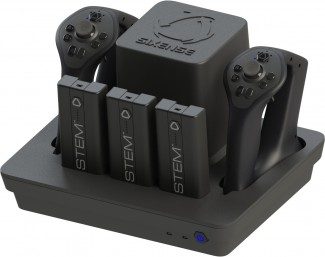
Sixense, creators of the tracking technology in the Razer Hydra, have been hard at work over the last year developing Hydra’s successor, STEM. The company has also recently announced that STEM will be compatible with Samsung’s Gear VR for both positional tracking and motion input. The company’s latest demo, a ping pong experience, shows off the accuracy and latency of the motion input system.
See Also: Three New STEM VR Controller Videos Show Incredible Lightsaber and Gun Interactions
A little recap for those just joining us. The first Oculus Rift development kit (DK1) didn’t include positional tracking, the ability to track a player’s head movements in 3D space. This was added to the second development kit, the Oculus Rift DK2, and it was considered a big deal because it greatly enhanced comfort and the feeling of immersion. In September, Samsung announced Gear VR, the company’s first mobile VR headset. However, Gear VR lacks positional tracking, which both Samsung and Oculus have acknowledged is not ideal.
STEM, a motion input controller for virtual reality, includes two controllers in addition to independent wireless tracking modules that can be attached to anything—weapons, accessories—even headsets. By attaching one of these modules to Gear VR, and with some integration using the SixenseVR SDK, positional tracking can be added entirely wirelessly.
See Also: Hands-on – IMU Added to Sixense STEM VR Motion Controller Underscores Impressive Performance
Now on to why this is a big deal. Positional tracking on the Oculus Rift DK2 is great, but due to its tethered nature, it works best for leaning around in your seat. You’ll have to put up with the cable if you want to want to move more extravagantly—or perhaps consider the Gear VR.
Sixense has developed an impressive new ping pong demo which shows the accuracy and low latency of STEM. And while the version shown below is played using the Oculus Rift DK2, it’s easy to envision how the untethered nature of Gear VR, combined with STEM, would allow players to move about the front of the table like they would while playing a serious round of real-life ping pong.
What we’re seeing here is the sort of gameplay that Kinect promised but couldn’t deliver. With latency low enough and tracking solid enough to not only hit the ball consistently, but even the ability to put spin on the ball—STEM looks to have a promising future in virtual reality input.
STEM was funded with a hugely successful Kickstarter last year and Sixense says they’re shipping their very first pre-production units this month, with shipping of the production units starting in 4-6 weeks.






